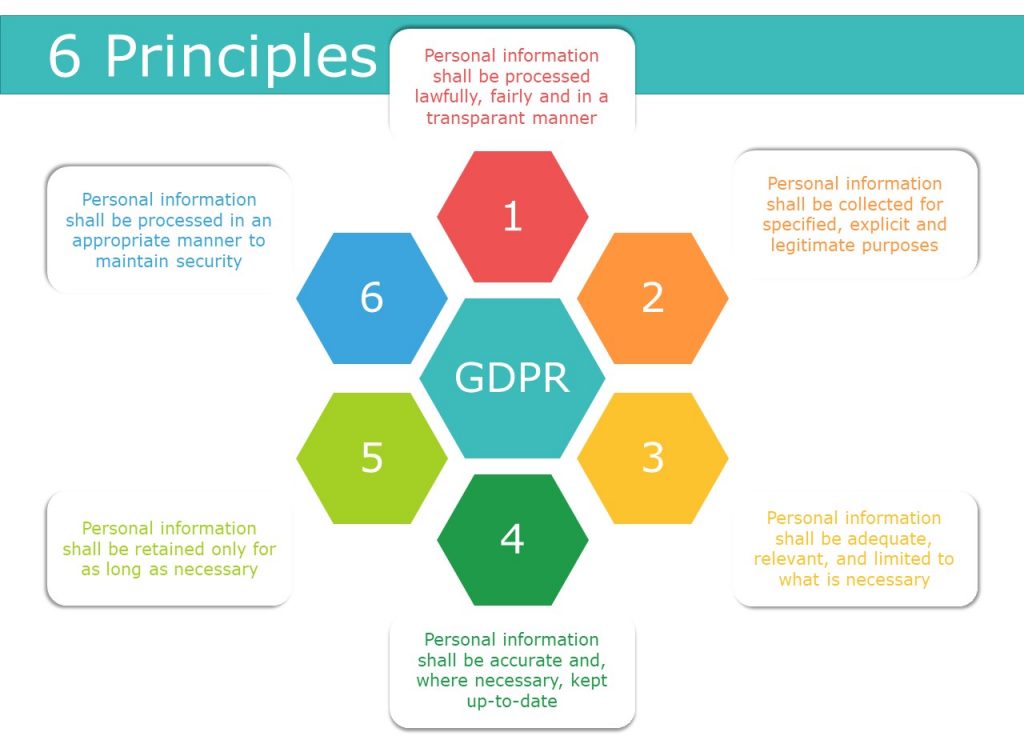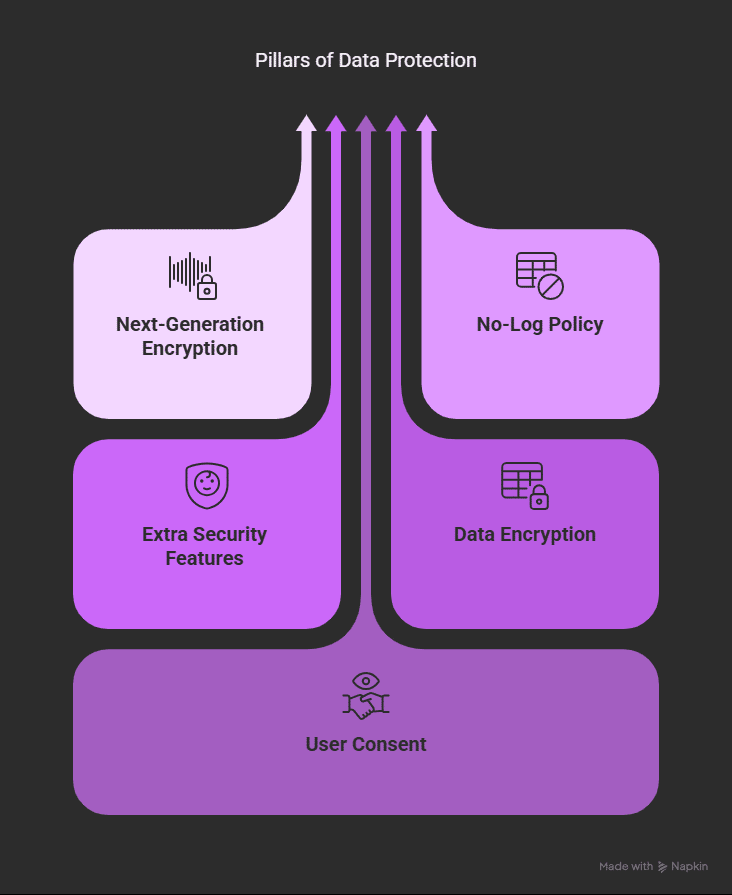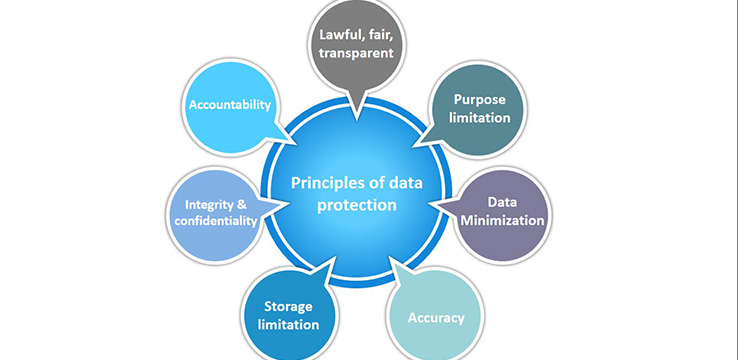Data protection is essential in today’s digital world. There are several principles designed to secure data.
But exactly how many data protection principles are there? Data protection principles are guidelines set to ensure the safety and privacy of personal information. Understanding these principles helps businesses and individuals comply with legal standards and protect sensitive data from breaches. This blog post will explore the different data protection principles, highlighting their importance and how they contribute to a secure digital environment. Whether you are a business owner, an employee, or a privacy-conscious individual, knowing these principles can help you safeguard your data effectively. For an extra layer of security, consider using a reliable VPN service like NordVPN.

Credit: elearning.vib.be
Introduction To Data Protection Principles
Data protection principles ensure personal data is handled securely and responsibly. These principles provide a framework for organizations to manage data effectively, safeguarding privacy and maintaining trust.
Importance Of Data Protection
The importance of data protection cannot be overstated in today’s digital age. Protecting this information is crucial with the increasing amount of personal data being collected, stored, and processed.
Prevents misuse: Proper data protection prevents unauthorized access and misuse of personal information.
Maintains trust: Ensuring data security helps maintain trust between businesses and their customers.
Compliance: Adhering to data protection laws and regulations avoids legal penalties.
For instance, a VPN service like NordVPN can enhance data protection by encrypting your internet connection and hiding your IP address.
Purpose Of Data Protection Principles
The primary purpose of data protection principles is to provide guidelines for the ethical and secure handling of personal data. These principles help organizations:
Ensure data accuracy: Maintaining accurate and up-to-date data prevents errors and misinformation.
Limit data usage: Data should only be used for specified and legitimate purposes.
Enhance transparency: Organizations must be transparent about their data handling practices.
Secure data: Implementing security measures protects data from breaches and cyber threats.
By following these principles, businesses can build a robust data protection strategy, ensuring the privacy and security of personal information.
Principle | Description |
|---|---|
Lawfulness, fairness, and transparency | Data should be processed lawfully, fairly, and transparently. |
Purpose limitation | Data should be collected for specified, explicit, and legitimate purposes. |
Data minimization | Only collect data that is adequate, relevant, and necessary. |
Accuracy | Ensure data is accurate and kept up to date. |
Storage limitation | Do not keep data longer than necessary. |
Integrity and confidentiality | Ensure data is secure and protected against unauthorized access. |
Accountability | Organizations must be responsible for their data handling practices. |
Overview Of Data Protection Principles
Understanding data protection principles is crucial in today’s digital age. These principles ensure that personal information is handled with care and respect. They provide a framework for organizations to manage data responsibly.
Definition And Scope
Data protection principles are guidelines designed to safeguard personal data. These principles ensure data is processed fairly, lawfully, and transparently. They also mandate that data is collected for specified, legitimate purposes and not used beyond those purposes.
Data protection principles encompass various aspects such as data collection, processing, storage, and deletion. These principles apply to both digital and physical forms of data. Organizations must comply with these principles to protect individuals’ privacy rights.
Historical Context And Evolution
The concept of data protection has evolved over the years. Initially, there were minimal regulations on data handling. However, as technology advanced, the need for robust data protection measures became evident.
In the 1970s, the first data protection laws were introduced in Europe. The Data Protection Directive 1995 marked a significant step in harmonizing data protection laws across EU member states. The introduction of the General Data Protection Regulation (GDPR) in 2018 further strengthened data protection by introducing stricter rules and higher penalties for non-compliance.
Today, many countries have data protection regulations, reflecting a global recognition of the importance of protecting personal data.
The Core Data Protection Principles
The core data protection principles are essential for maintaining the security and privacy of personal data. These principles guide organizations in handling data responsibly, ensuring it is protected from unauthorized access and misuse. Let’s explore each principle in detail.
Lawfulness, Fairness, And Transparency
Data must be processed lawfully, fairly, and transparently. Lawfulness ensures that data processing complies with legal requirements. Fairness means the processing should not adversely affect individuals. Transparency requires clear communication about how data is used.
Purpose Limitation
Data should be collected for specified, explicit, and legitimate purposes. It should not be processed further in a way incompatible with those purposes.
Data Minimization
Only data that is necessary for the specified purposes should be collected. This principle ensures that organizations do not hold excessive personal data.
Accuracy
Personal data must be accurate and kept up to date. Inaccurate data should be corrected or deleted promptly to ensure reliability.
Storage Limitation
Data should not be kept longer than necessary. Organizations must establish retention periods to comply with legal and operational requirements.
Integrity And Confidentiality
Personal data should be processed securely to protect against unauthorized or unlawful processing, accidental loss, destruction, or damage. This includes using appropriate technical and organizational measures.
Accountability
Organizations must be responsible for complying with all principles. They should demonstrate compliance through documentation and by implementing data protection policies and measures.
How Each Principle Benefits Organizations And Individuals
Understanding data protection principles is crucial. These principles safeguard personal information and provide significant benefits to organizations and individuals.
Enhancing Trust And Reputation
Adhering to data protection principles builds trust with customers. They feel safe knowing their data is secure. This trust enhances the organization’s reputation, making it a preferred choice for many.
A good reputation leads to customer loyalty. It also attracts new customers. Trustworthiness becomes a competitive advantage.
Ensuring Legal Compliance
Following data protection principles ensures legal compliance. Organizations avoid hefty fines and legal actions. They stay compliant with regulations like GDPR.
Compliance reduces legal risks. It also saves the organization from potential financial losses. Legal compliance is essential for smooth business operations.
Protecting Personal Information
Data protection principles focus on protecting personal information. They prevent unauthorized access and data breaches. This protection is vital for maintaining individual privacy.
Personal information protection builds confidence among users. They are more likely to share their data, knowing it is secure. This increases data quality and utility for businesses.
Facilitating Data Management
Data protection principles aid in facilitating data management. They provide a structured approach to data handling. This makes data easier to manage and process.
Effective data management improves operational efficiency. It ensures accurate and reliable data. Organizations can make informed decisions based on high-quality data.
Challenges In Implementing Data Protection Principles
Ensuring data protection is a critical aspect of modern digital operations. Implementing data protection principles involves several challenges. These challenges can arise from technological and organizational barriers, the need to balance privacy and innovation, and the cost implications associated with data protection.
Technological And Organizational Barriers
Technological and organizational barriers often hinder the effective implementation of data protection principles. For instance, integrating advanced security measures such as encryption and no-log policies can be complex and resource-intensive.
Organizations must adapt their infrastructure to support these technologies. They also need to educate their staff about the importance of data protection. This includes training using tools like NordVPN, which offers features like Threat Protection and next-generation encryption.
Another barrier is the rapid evolution of technology. Keeping up with the latest security threats and protective measures requires continuous investment and adaptation.
Balancing Privacy And Innovation
Balancing privacy and innovation is a delicate task. On one hand, there is a need to protect users’ data. On the other hand, there is a need to innovate and provide enhanced services.
For example, services like NordVPN provide secure access to geo-blocked content and support features like Double VPN and Onion Over VPN. These features enhance user experience but require robust data protection measures to ensure privacy.
Organizations must find a way to innovate without compromising on data privacy. This often requires carefully evaluating the risks and benefits associated with new technologies and features.
Cost Implications
Cost implications are a significant challenge in implementing data protection principles. Ensuring robust data protection requires substantial financial investment.
For example, deploying advanced tools like NordPass for password management and NordLocker for file encryption can be costly. These tools provide enhanced security but come with a price.
Additionally, organizations must allocate resources for continuous monitoring, maintenance, and updates to their data protection systems. This includes investing in employee training programs to stay updated with the latest security practices.
Despite these challenges, data protection is crucial for maintaining user trust and ensuring the security of sensitive information.
Credit: safedatagov.com
Real-World Applications And Case Studies
Data protection principles play a crucial role in ensuring the security and privacy of personal information. Understanding how these principles are applied in real-world scenarios helps to appreciate their significance. This section delves into successful implementation examples and lessons learned from data breaches.
Successful Implementation Examples
Several organizations have successfully implemented data protection principles, ensuring robust security measures and compliance. Here are a few notable examples:
NordVPN: NordVPN uses next-generation encryption (AES-256) to secure user data. Their no-log policy ensures that no private information is collected or stored. With features like Double VPN and Onion Over VPN, NordVPN provides an extra layer of security, making it popular among journalists, activists, and privacy-conscious users.
Google: Google follows stringent data protection principles by implementing data encryption both in transit and at rest. They ensure user consent for data collection and provide transparency about data use.

Lessons Learned From Data Breaches
Data breaches offer valuable lessons on adhering to data protection principles. Here are some significant insights:
Equifax Breach: The 2017 Equifax breach exposed the personal data of 147 million people. The breach highlighted the need for regular security updates and vulnerability management. Equifax failed to apply a critical security patch, which led to massive data exposure.
Yahoo Breach: Yahoo suffered multiple breaches between 2013 and 2014, affecting 3 billion accounts. The incidents emphasized the importance of strong encryption and user notification. Yahoo’s delayed disclosure of the violations led to a loss of trust and significant financial penalties.
Conclusion And Future Outlook
The principles of data protection are essential in our digital age. They ensure that personal information is handled responsibly and securely. As we move forward, understanding these principles becomes even more crucial.
The Evolving Landscape Of Data Protection
The landscape of data protection is constantly changing. New technologies and regulations are emerging. Organizations must stay updated to comply with these changes. For instance, the General Data Protection Regulation (GDPR) set a new standard for data protection. Similar regulations are now being adopted worldwide.
Tools like NordVPN are becoming essential for privacy-conscious individuals. NordVPN offers advanced encryption, a strict no-logs policy, and features like Double VPN and Onion Over VPN. These features help in maintaining online privacy and security.
NordVPN also provides protection against malware, ads, and trackers. It supports multiple devices, making it a versatile choice for users. With its extensive server network and high-speed connections, NordVPN is ideal for streaming and torrenting.
Key Takeaways For Organizations And Individuals
Organizations should implement robust data protection measures. Regularly updating security protocols is vital. Employees should be trained on data protection principles. Using tools like NordVPN can enhance security. It helps in encrypting internet connections and hiding IP addresses.
Individuals must also take steps to protect their data. Using services like NordVPN can provide an added layer of security. It is beneficial for accessing geo-blocked content and securing public Wi-Fi connections. NordVPN’s user-friendly interface and quick connect feature make it easy to use.
NordVPN’s promotional offer makes it an affordable option. The service is available at a reduced cost with a 30-day money-back guarantee. This makes it a cost-effective solution for enhancing online privacy and security.

Credit: seersco.com
Frequently Asked Questions
What Are The 8 Principles Of Data Protection?
The 8 principles of data protection are: 1. Lawfulness, fairness, and transparency 2. Purpose limitation 3. Data minimization 4. Accuracy 5. Storage limitation 6. Integrity and confidentiality 7. Accountability 8. Data subject rights These principles ensure safe and effective data handling.
Are There 6 Or 7 Gdpr Principles?
There are 7 GDPR principles. These principles ensure data protection and privacy, covering transparency, minimization, and security.
What Are The 7 Principles Of Data Security?
The 7 principles of data security are Confidentiality, Integrity, Availability, Authentication, Authorization, Accountability, and Non-repudiation. These principles ensure data is protected from unauthorized access, remains accurate, is accessible when needed, verifies user identities, controls access permissions, tracks actions, and prevents denial of actions.
How Many Data Protection Are There?
Several data protection laws exist globally, including GDPR, CCPA, HIPAA, and others. Each region may have its own regulations.
Conclusion
Understanding data protection principles is crucial in today’s digital age. These principles help safeguard our personal information. They ensure privacy and security online. For enhanced online security, consider using NordVPN. It offers advanced encryption and a strict no-logs policy. Protect your data effectively with NordVPN. It’s user-friendly and works on multiple devices. Stay secure and private online with ease. Choosing the right tools ensures your data remains safe. Remember, protecting your data is essential. Stay informed, stay safe.
